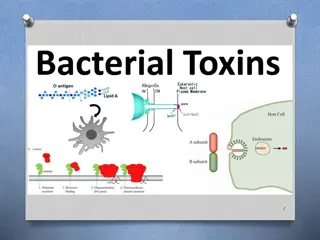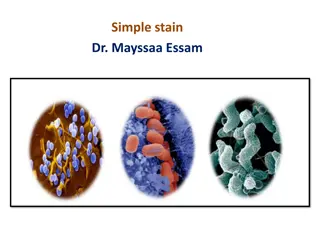Understanding Bacterial Cell Structure and Function
Bacteria display unique cellular structures and functions that differ from eukaryotic cells. They have a simple structure with a plasma membrane but lack complex internal membrane systems. The cytoplasm contains inclusion bodies, ribosomes, and genetic material in the nucleoid. Bacteria can be categorized as gram-positive or gram-negative based on cell wall characteristics. The cell wall always contains peptidoglycan, and structures like capsules and flagella aid in various functions. Cell organization in bacteria involves crucial processes at the cell membranes and plasma membrane, which serve as selective barriers for nutrient uptake and waste excretion. The plasma membrane also facilitates metabolic processes like respiration and lipid synthesis.
Download Presentation

Please find below an Image/Link to download the presentation.
The content on the website is provided AS IS for your information and personal use only. It may not be sold, licensed, or shared on other websites without obtaining consent from the author. Download presentation by click this link. If you encounter any issues during the download, it is possible that the publisher has removed the file from their server.
E N D
Presentation Transcript
Bacterial cell Structure and function By Hadeel Kareem Musafer PhD
Bacterial cell Structure and function Bacteria are small and simple in structure when compared with eukaryotes, they often have characteristic shapes and sizes. They have a plasma membrane which is required by all living cells, but lack extensive, complex internal membrane systems.
The cytoplasmic matrix typically contains several constituents that are not membrane-enclosed: inclusion bodies, ribosomes and the nucleoid which it s genetic material. Most bacteria can be divided into gram-positive and gram-negative groups based on their cell wall structure and appearance under the microscope.
Cell wall always has peptidoglycan. Components like capsules and fimbriae are located outside the cell wall. Bacteria use flagella to swim toward attractants and away from repellents. Some bacteria form resistant endospores to survive harsh environmental conditions in a dormant state.
Cell organization A variety of structures are found in bacterial cell their functions summarized as following: 1.Cell membranes Bacterial cell interact with the surrounding environment in a selectivity way. Cells must be able to acquire nutrients and eliminate wastes outside the cell. Also have to maintain their interior in a constant, highly organized state to face the external changes.
2. Plasma membrane Plasma membrane is the essential point of contact with the surrounding cell s environment, thus it is necessary to understand their structure. Membrane contain both proteins and lipids. It is usually have a higher proportion of protein, lipids are two types: polar and non polar.
The plasma membrane serves as a selectively permeable barrier; it allows particular ions and molecules to pass either into or out of the cell, while preventing the movements of others. Transport systems can be used for nutrient uptake, wastes excretion, and protein secretion.
Plasma membrane also is the location of a variety of crucial metabolic processes such as respiration, Photosynthesis, lipidssynthesis, cell wall constituents and chromosome segregation. It contains special receptor molecules that help bacteria detect and respond to chemicals.
3. Bacterial cell wall Rigid layer lies outside the plasma membrane. It is one of the most important parts of bacterial cell for several reasons: it is strong wall that give bacteria it s shape and protect them from osmotic lysis. The cell wall have components that contribute to their pathogenicity, it can protect a cell from toxic substances as well as it is the site of action of several antibiotics.
Peptidoglycan structure: thick, homogeneous layer in gram-positive bacterial cell wall while it is thin in gram-negative, it helps give cell wall negative charge, they may be important in maintaining the structure of the wall because of their chemical structure.
Outer membrane lies outside peptidoglycan the most unusual constituents of the outer membrane are it s lipopolysaccharide(LPS); large, complex molecules contain both lipid and carbohydrates, consist of; lipid A, core polysaccharide and the O-side chain.
LPS is important for several reasons, it contributes to the negative charge on the bacterial surface and helps stabilize membrane structure. Lipid A is toxic layer so it can act as endotoxin and cause some of the symptoms that arise in gram-negative bacterial infections.
A most important outer membrane function is to serve as a protective barrier. It prevents or slow entry of bile salts, antibiotics, and other toxic substances that might kill or injure the bacterium. Outer membrane is more permeable than the plasma membrane and permits the passage of small molecules like glucose and other monosaccharide due to presence of special porin proteins.
4. Components External to the Cell Wall Bacteria have a variety of structures outside the cell wall that employ in protection, attachment to objects and cell movement such as: Capsule is a layer of material lying outside the cell wall; composed of well-organized polysaccharides, it provide several advantages helps bacteria resist phagocytosis and protect them against desiccation because containing large amount of fluid, as well as excluding bacterial viruses and most hydrophobic toxic materials such as detergents.
Fimbriae: short, fine, hair like appendages that are thinner than flagella and responsible for bacterial attachment and required for the twitching and gliding motility or movement. Sex pili: short appendages, larger than fimbriae, they are genetically determined by sex factors or conjugative plasmids and required for bacterial transformation. Flagella: threadlike appendages extending outward from the plasma membrane and cell wall, they are slender, thin, rigid structures used for bacterial movement.
Chemotaxis: is the movement of bacterial cells toward chemical attractants and away from repellents, they attracted by such nutrients such as sugars and amino acids while repelled by many harmful substances. Bacterial cells response to other environmental condition such as temperature, light and gravity.
Bacterial endospore; a number of gram-positive bacteria like Bacillus spp Clostridium can form a special resistant dormant structure called an endospore during a complex process called sporulation or sporogenesis (spore formation) which is begin when growth ceases due to lack of nutrients, spores are resistant to environmental stresses such as heat, ultraviolet and gamma radiation, chemical disinfectants and desiccation so endospores are of big issue in food, industrial and medical microbiology.
Bacterial cell wall Figure- 1 Bacterial cell wall
References References 1. Microbial Physiology. Albert G Moat, John W Foster, Michael P. Spector. 2002. Fourth Edition. A John Wiley and sons, INC., publication. 2. Microbiology. Lansing M Prescott, John P. Harley, Donald A. Klein.2004. Sixth Edition. Higher Education. 3. Microbial an introduction. 2004. Gerard J Tortora, Berdell R Funke, Christine L Case. Eighth Edition.























